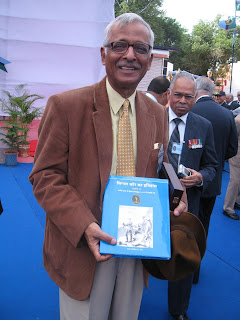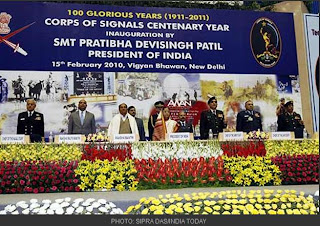Corps History Committee
Though no history of the Corps was published during the period 1947-72, most of the work including the writing of the script of Volume I covering the period 1911-39 was completed during this time. The story of the ups and downs connected with the publication of the book has been covered in ‘History of the History’ which forms Appendix 1 of Volume II. However, the deliberations of the Corps Committee concerning the history of the Corps and other subjects within the purview of the Corps History Committee which are relatively unknown will be covered here.
The Corps Committee, in its very first meeting held in September 1946, ‘agreed that it was most desirable that the history of the Indian Signal Corps should be compiled’. However, nothing much seems to have been done during the next few years except a visit to the Historical Section in Simla by the Deputy Director Signals in early 1953 and the initiation of a case for a lieutenant colonel to write the Corps history. The lieutenant colonel and his staff were sanctioned, but due to acute shortage of officers in the Corps, no officer could be provided for this task. 69
Fortunately, Colonel T Barreto was posted as Deputy Director of Signals from 1953-56. Without any mandate from the Corps Committee, he had begun collecting material in 1951, when he was at the Staff College, and continued his efforts during his tenure at Delhi. This naturally came to the knowledge of Brigadier Akehurst and Brigadier Iyappa, who succeeded him in 1954. In 1957, the Corps Committee agreed that the compilation of the history of the Corps is a long outstanding necessity. They appreciated the effort already put in by Brigadier Barreto and requested him to accept the responsibility to complete the Corps history, sanctioning a sum of Rs. 1000/- for expenses.
By this time Brigadier Barreto had moved to Poona as CSO Southern Command. He was nominated Chairman of the Corps History Committee, an appointment he held until his retirement in 1965. During his tenures at Poona (1956-60); Simla (1960-63) and Mhow (1963-65), he continued to work assiduously on the project. He presented the first report of the Corps History Committee during the 11th Corps Committee Meeting in 1958. Thereafter, he presented progress reports in every meeting of the Corps Committee up to 1965, which was the last meeting he attended. During this meeting, he informed the Committee that the manuscript of Volume I of the History of the Indian Signal Corps was almost ready. In the absence of the Chairman, Lieutenant General Iyappa, the meeting was chaired by the Co-Chairman, Major General Batra, who stated that he had discussed the matter with the Senior Colonel Commandant. As the printing of the Volume would require last minute coordination with the printers, it would be printed in India. It had been decided that the services of Lieutenant Colonel Proudfoot be engaged for technical vetting of the manuscript and processing till its final publication.
The decision to engage Lieutenant Colonel Proudfoot could not have been taken kindly by Brigadier Barreto. It indicated a lack of confidence in his abilities which was totally unjustified. That this was done without consulting him was even more galling. Due to various reasons, he put in his papers and retired prematurely in June 1965, when he was the Commandant of the School of Signals. Before he retired, he was asked to hand over the manuscript and all the material collected by him painstakingly over the previous 10-15 years.
Though the manuscript had been completed by Brigadier Barreto before he retired, the project went into limbo after his departure, with the Corps not being able to find a suitable replacement to head the Corps History Committee. The next meeting of the Corps Committee records:
Since the retirement of Brig T BARRETO a new Chairman of the Corps History Committee has not yet been appointed in his place. No report has, therefore, been prepared for discussion. CSO Central Command stated that the present system of collecting data for the compilation of Corps History entailed delay and therefore the system should be revised and the responsibility entrusted to a training establishment to whom copies of war diaries and other materials of historical value to the Corps should be made available. He also stated that it may be advantageous to employ a retired officer who may progressively compile the History and keep it up-to-date.
In 1967 the Corps Committee was informed that the only nomination received so far for ‘writing’ the Corps history was that of Lieutenant Colonel A Asirvadam of the School of Signals. Brigadier KD Bhasin stated that he had informally contacted Brigadier Barreto who had declined to undertake the task. The Chairman, Lieutenant General Iyappa, asked the SO-in-C, Major General ID Verma to discuss this issue with Brigadier Barreto during his next visit to Jabalpur. Meanwhile, all the material still held with Brigadier Barreto was to be taken over from him and properly compiled to facilitate further work. Major GY Sowani of 1 STC was to carry out processing of Volume I and start writing the draft for Volume II. The draft written Major Sowani was to be passed on to Colonel SN Mehta for vetting and finalisation.
For the next four years literally nothing was done with regard to the Corps history. The subject was also not discussed by the Corps Committee during the meetings held in 1968, 1969 and 1970. In 1971 Commandant 1 STC placed before the Corps Committee the list of items which had been collected from Brigadier Barreto and kept in the Corps Museum. The Chairman, Lieutenant General Iyappa then suggested that it is time we take some concrete action to publish the Corps history. CSO Southern Command stated that Lieutenant Colonel GY Sowani had volunteered to do the work. (This had been approved by the Committee four years earlier). Initially he should be moved to Jabalpur on temporary duty to make an assessment of the volume of work involved and later he may be posted to Jabalpur if necessary.
In the event, after Colonel GY Sowani also begged off, various other writers approached, including Lieutenant Colonel CL Proudfoot, Colonel Pyara Lal Colonel V Anantahraman, Major KS Kapur Brigadier KD Bharagava and Lieutenant Colonel JC Dhamija. Volume I of the Corps History was finally published in 1975, ten years later after its completion by Brigadier Barreto. The book was a verbatim reproduction of the original draft except for a change in the title. The preface written by Brigadier Barreto was omitted and so was his name as the author. One can only wonder at the lackadaisical manner in which the Corps history project was addressed by the Corps Committee and the callous manner in which it treated one of its most distinguished members. Brigadier Barreto had been the longest serving member of the Corps Committee, except for General Iyappa. 6/7/2010
Maj Gen VK Singh (Retd)
Comment: Wonderful insight into the ordeals and challenges confronted in getting the Corps History Published. Brig Barreto and Maj Gen VK Singh are the true time keepers of Corps of Signals for perpetuity.
 CAPTAIN MONTAGUE LAMBERT RE
CAPTAIN MONTAGUE LAMBERT RE











